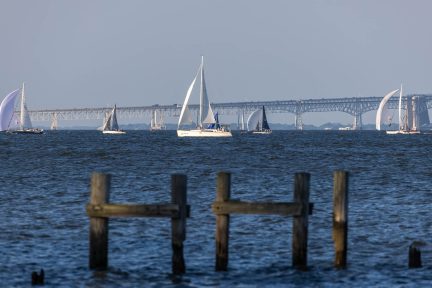Report from the National Academy of Sciences Reinforces New Direction Chesapeake Bay Program is Head
Report from the National Academy of Sciences Reinforces New Direction Chesapeake Bay Program is Head
The National Research Council of the National Academy of Sciences (NAS) pilot study, released today, supports the work that has been undertaken in the last 18 months by the Chesapeake Bay Program (CBP), who solicited this self-evaluation in 2009.
The new study, “Achieving Nutrient and Sediment Reduction Goals in the Chesapeake Bay: An Evaluation of Program Strategies and Implementation,” is constructive and generally focuses on accountability. Its purpose has been to increase understanding of the ways that the CBP can evaluate its efforts for cleaning up the Bay by achieving nutrient reduction goals.
"While supporting the program’s current efforts, the report also points out some critical challenges to consider in making decisions moving forward,” said EPA Mid-Atlantic Regional Administrator Shawn M. Garvin, Chair of the CBP’s Principle Staff Committee (PSC). "We welcome the report’s recommendations for strengthening the accountability of the Chesapeake Bay Program Partnership."
The NAS results reinforce the partnership’s work currently underway including the Bay Total Maximum Daily Load (TMDL), the Bay jurisdiction’s Watershed Implementation Plans (WIP), and the two year milestones. It also provides suggestions for strengthening processes in the areas of: tracking and accounting of Best Management Practices (BMPs); assessing milestones; adaptive management; and implementation strategies. CBP will evaluate and consider the science-based conclusions and recommendations offered by NAS in its future planning and implementation.
"Many of these findings also support Maryland's ongoing efforts,” said Maryland Department of the Environment Secretary Robert M. Summers, “particularly our work to hold ourselves accountable through the Maryland BayStat process, regular tracking of progress on our two-year milestones, and development of a strong Watershed Implementation Plan. These recommendations come at an opportune time for the Bay as we work with local jurisdictions on the details of Phase II Watershed Implementation Plans. With a renewed focus on Bay restoration at Federal, State and local levels, we believe a healthy Chesapeake Bay is finally within our sights, and we look forward to working with our partners to determine how the Academy's recommendations can help."
In 2008, the Executive Council of the CBP – the partnership’s top-level leadership that includes the EPA Administrator, the governors of the Bay watershed states, the Mayor of Washington, D.C. and the chair of the Chesapeake Bay Commission – requested that the Program be evaluated by a nationally-recognized, independent, science organization. The NAS analysis began the following year. The purpose of the study was to evaluate the CBP implementation efforts to achieve the nutrient reduction goals for water quality in order to accelerate reaching the protection and restoration of the Chesapeake Bay. It was jointly funded by the US Environmental Protection Agency/Chesapeake Bay Program (CBP), the District of Columbia, Maryland, Pennsylvania, and Virginia.
In the process of conducting this study, NAS recognized the complexity of the Bay watershed, the equally intricate tracking systems required to accurately report on progress and the fact that CBP is in the process of better integrating its voluntary and regulatory work. The CBP partnership will provide a written response to all the recommendations within a 90 day period.
Visit CBP’s website for information and a link to the NAS report: http://www.chesapeakebay.net



